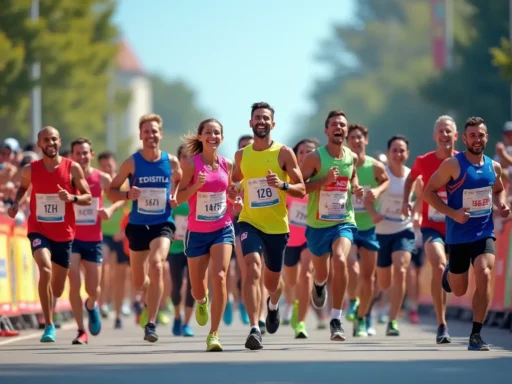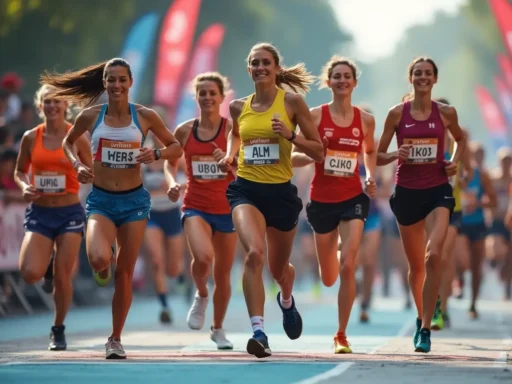Getting ready for a 10K race means knowing the distance. You might ask, how many miles is a 10k? It’s 6.2 miles. This knowledge helps you make a training plan that suits you, helping you reach your goals.

Knowing the distance of a 10K run is key. With 6.2 miles to cover, focus on building your endurance. This way, you’ll be ready for the race. A good training plan, based on the 10K distance, helps you stay focused and succeed.
Table of Contents
Understanding How Many Miles Is a 10K
To figure out how many miles a 10K is, we need to convert kilometers to miles. Since 1 kilometer is about 0.6 miles, a 10K race is 6.2 miles. Knowing this helps you plan your training for the race.
When you ask how many miles a 10K run is, think about the distance and your fitness level. A 10K is a big distance. Knowing how to convert kilometers to miles is key for your training. The time it takes to finish a 10K can vary, but it’s usually between 50–70 minutes.
The Metric to Imperial Conversion
The conversion from kilometers to miles is simple: 1 kilometer is 0.621371 miles. To convert, use the formula: Miles = Kilometers × 0.621371. For a 10K, this is 10 kilometers × 0.621371 = 6.21371 miles, or about 6.2 miles.
Breaking Down the Distance
Understanding the distance of a 10K run helps grasp the challenge. A 10K is 6.2 miles, a big distance. Men’s average mile pace in a 10K is under 9 minutes, and women’s is about 10 minutes.
Common Race Variations
There are different race lengths, like the half marathon and marathon. Knowing these distances helps in distance running. For example, a half marathon is 13.1 miles, and a marathon is 26.2 miles. Knowing the 10K distance prepares you for these longer races.
| Distance | Miles |
|---|---|
| 10K | 6.2 miles |
| Half Marathon | 13.1 miles |
| Marathon | 26.2 miles |
Why the 10K Distance Is Perfect for Runners
Ever wondered how many miles a 10k is? It’s about 6.2 miles. This distance is great because it balances endurance, speed, and strategy. It’s a good challenge for beginners and a stepping stone for more experienced runners.
Running a 10K is great because it doesn’t take too much time to train. You only need about an hour per session. This helps improve your heart health without overdoing it. It’s perfect for those who want to stay active but don’t have a lot of time.
Some benefits of running a 10K include:
- Improved cardiovascular fitness
- Increased speed and endurance
- Reduced risk of muscle damage compared to longer distances
- Opportunities for fundraising and community engagement
Running experts say the 10K is ideal for times between 40 to 60 minutes. The average finish time is 49:43 minutes. Whether you’re new to running or have experience, the 10K is a great way to challenge yourself and feel accomplished.
Essential Gear for 10K Training
Training for a 10K run means getting ready for about 6.2 miles. It’s key to have the right gear for success. You’ll need proper running shoes, performance clothes, and training tools.

Here are some important items to start with:
- Running shoes: Choose shoes that offer support and cushioning. NIKE Alphafly and Asics Metaspeed Sky are good choices.
- Performance clothing: Opt for clothes made of moisture-wicking materials like polyester and nylon. They help prevent chafing and discomfort.
- Training accessories: Get a watch or fitness tracker to track your progress and stay motivated.
Make sure to test your gear before the race. Wear layers based on the weather forecast. Also, use running-specific socks to avoid blisters. With the right gear, you’ll be ready to run the 10K with confidence.
Physical Requirements for a 10K Race
To understand the physical needs for a 10K race, it’s key to know how many miles is a 10k. A 10K race is 6.2 miles long. It demands good cardiovascular health, muscle strength, and flexibility. Runners must have a solid aerobic base to keep a steady pace.
Some important physical traits needed for a 10K race include:
- Cardiovascular endurance to maintain a steady pace
- Muscular strength to support running form and reduce injury risk
- Flexibility and mobility to maintain good running form
For instance, a beginner might take 50-70 minutes to finish a 10K. An advanced runner can do it in under 40 minutes. Knowing how many miles is a 10k and the physical needs helps runners prepare and train well for the race.
Building Your Base Fitness Level
To figure out how many miles are in a 10k run, remember that a 10k is 10 kilometers or 6.2 miles. Building your base fitness for a 10k run needs a good training plan. This plan should include cardio, strength training, and work on flexibility and mobility. A solid aerobic base building plan can greatly improve your running.
A study showed that a runner can cut their 5km time by over 1 minute in 8 weeks with a good aerobic base plan. Building an aerobic base takes 8–12 weeks. Most of your training should be at an easy intensity, with weekly mileage increasing by 5–10% each week. Also, include a deload week every 4th week, where you reduce your mileage by 30–50%.
Cardiovascular Preparation
Cardiovascular preparation is key for your base fitness. Your training plan should mix easy runs, tempo runs, and long slow runs. A typical 10k training plan includes 3 to 5 runs a week, with a longer run on weekends. The long run should be 25–35% of your weekly mileage for 4 or more runs.
Strength Training Fundamentals
Strength training is also vital for your base fitness. It involves exercises like squats, lunges, and deadlifts that target your core, glutes, and legs. This can make your running more efficient and lower your injury risk.
Flexibility and Mobility Work
Flexibility and mobility work are also important. They help improve your range of motion and lower injury risk. Exercises like stretching and foam rolling are good for this. Adding these to your training plan can boost your fitness and safety.
| Weekly Mileage | Number of Runs |
|---|---|
| Less than 25km | 3 runs |
| 25-40km | 4 runs |
| 45-70km | 5 runs |
| More than 70km | 6 or more runs |
Creating Your Weekly Training Schedule
To figure out how many miles is a 10k, remember a 10K race is about 6.2 miles. Your weekly training plan should mix running, cross-training, and rest. This balance helps you recover and get better. Include easy runs, interval training, and long runs, plus activities like cycling or swimming.
A typical weekly plan for a 10K might look like this:
- 1 day of speed work
- 1 steady run focused on 10K pace
- 1 longer steady run that builds up to 10K (6.2 miles)
- At least 2 days of rest
Here’s an example of what your weekly mileage could be:
| Day | Activity | Mileage |
|---|---|---|
| Monday | Rest | 0 |
| Tuesday | Easy run | 3 miles |
| Wednesday | Cross-training | 0 |
| Thursday | Speed work | 4 miles |
| Friday | Rest | 0 |
| Saturday | Long run | 6.2 miles |
| Sunday | Easy run | 3 miles |
Always listen to your body and adjust your plan if needed. Proper nutrition and hydration are key to support your training. With a good training schedule and understanding of 10K distances, you’ll reach your goals.
Nutrition Strategies for 10K Success
Getting ready for a 10K run means knowing how many miles it is. But it’s also key to eat the right foods. A good diet can really help you do well in the race. Aim for a mix of carbs, protein, and fat in your meals.
For a 10K runner, you should eat 45-55% carbs, 15-20% protein, and 25-35% fat. This means about 375 grams of carbs, 90 grams of protein, and 112.5 grams of fat for a 75 kg runner. Also, drink lots of water and electrolytes, especially when running long.
Pre-Training Meal Planning
Eat complex carbs with every meal before the race. Choose foods high in carbs but low in fiber for easy digestion. Your pre-race meal should be 60-70% carbs, with some protein and little fat to avoid feeling slow.
Race Day Nutrition
On race day, have a carb-heavy breakfast 2-3 hours before. Then, eat a snack 1-2 hours before. This snack should be 150-250 calories, with 75%-80% carbs, 10-15% protein, and 10% fat.
Post-Run Recovery Fuel
After the race, eat carbs and protein within 30-60 minutes to recover fast. Good choices include chocolate milk and recovery shakes. By following these tips, you’ll be ready for a great 10K run, knowing how to fuel your body right.
| Nutrient | Recommended Daily Intake |
|---|---|
| Carbohydrates | 45-55% of total calories |
| Protein | 15-20% of total calories |
| Fat | 25-35% of total calories |

Common Training Mistakes to Avoid
When training for a 10K, knowing how many miles it is is crucial. You need a solid plan to avoid common mistakes. These include overtraining, not getting enough rest, and poor nutrition.
To make the most of your training, keep these tips in mind:
- Make sure to take rest days to prevent burnout and tiredness
- Do strength training 2 times a week to boost your performance and stay injury-free
- Replace your running shoes every 300-500 miles to keep your feet supported and safe
Don’t ignore mental training as it’s vital for staying motivated and confident. Eating right, with lots of carbs, protein, and healthy fats, is also key for top performance and recovery. By avoiding these mistakes, you can have a successful and injury-free 10K training journey, no matter the distance.
Remember, a good training plan and a positive attitude are essential. Stay focused, and you’ll soon finish your 10K, knowing exactly how many miles it is.
Tracking Your Progress and Pace
Training for a 10K run means keeping an eye on your progress and pace. Knowing a 10K is 6.2 miles helps set goals and track your growth. Running apps, heart rate monitors, and milestone goals keep you motivated and help adjust your plan.
To track your progress, consider these methods:
- Using running apps, such as Nike Run Club or Strava, to monitor your distance, pace, and heart rate
- Investing in a heart rate monitor to track your physical exertion and optimize your performance
- Setting milestone goals, such as completing a certain number of runs per week or achieving a personal best time
Tracking your progress helps spot areas for improvement. If you struggle to keep a steady pace, add more speed work or hill training. Always keep your goals in mind and celebrate your wins, no matter how small.
| Training Method | Benefits |
|---|---|
| Running Apps | Monitor distance, pace, and heart rate |
| Heart Rate Monitoring | Track physical exertion and optimize performance |
| Setting Milestone Goals | Stay motivated and focused on goals |
Race Day Preparation Tips
As you get ready for your 10K race, remember it’s 6.2 miles long. To do well, focus on nutrition, hydration, and the right gear. Eat a balanced meal like a banana in a tortilla with nut butter or 2 slices of toast with peanut butter 1-2 hours before the race.
Do a dynamic warm-up with a light run of up to 1 mile and 3-4 strides. It’s also key to bring water and snacks to the start. Try to pace evenly, aiming for a consistent speed throughout. Running the second half faster than the first is a good strategy.
Here are some more tips to remember:
- Drink coffee about 45 minutes before the race for a boost
- Don’t overdo carb-loading the week before to avoid stomach issues
- Use a GPS or running watch to keep track of your pace
- Only take one energy gel during the race, as you won’t need much
By following these tips, you’ll be ready for a great race. Stay focused, keep a steady pace, and use familiar gear. With the right prep and pacing, you can conquer the final miles and reach your goal.
| Pace Range | Time |
|---|---|
| 5:59 minutes per kilometer | Under 1 hour |
| 5:00 minutes per kilometer | 50 minutes |
| 4:30 minutes per kilometer | 45 minutes |
Recovery and Rest Strategies
After a 10K run, which is 6.2 miles, your body needs time to heal. Knowing how many miles a 10K run is shows why recovery is key. It helps avoid injuries and boosts performance.
Getting enough sleep and using methods like foam rolling and stretching are crucial. These actions reduce muscle soreness and improve flexibility. A balanced diet also fuels your body’s repair and rebuild process.
Active Recovery Methods
Active recovery is vital for muscle recovery. It promotes blood flow and eases soreness. Here are some active recovery methods:
- Light jogging or cycling
- Swimming or other low-impact activities
- Yoga or Pilates
- Foam rolling and stretching
Sleep and Regeneration
Sleep is essential for recovery, with 7-9 hours needed each night. It helps repair and regenerate muscle tissue. This improves performance and lowers injury risk. Try to sleep well by avoiding heavy meals and screens before bed.
| Recovery Strategy | Benefits |
|---|---|
| Active Recovery | Reduces muscle soreness, promotes blood flow |
| Sleep and Regeneration | Repairs and regenerates muscle tissue, improves performance |
| Nutrition | Provides fuel for recovery, supports muscle growth and repair |
Using these recovery strategies can help your body bounce back from a 10K run. Listen to your body and adjust your plan as needed. Remember, recovery is as important as training.
Managing Mental Challenges
Getting ready for a 10K race means knowing it’s 6.2 miles long. This knowledge helps you plan your mental game. Mental prep is as important as physical training for a 10K win. By learning to handle your mind, you can stay focused and motivated, no matter what.
Visualization and positive self-talk are great for mental challenges. Seeing yourself finish and saying positive things to yourself boosts your confidence. Also, breaking the race into parts makes it easier to manage. Think of the first 3 km as a warm-up, km 4-6 as the hard part, and km 7-9 as the toughest.
Here are some tips for mental challenges:
- Set achievable goals and train for 3 to 4 months.
- Divide the race into smaller parts, like 5k blocks.
- Use positive affirmations to get through tough times.
- Have a consistent pre-race routine to calm your nerves.
Using these strategies in your training builds mental strength. Knowing the race distance is just the beginning. It’s how you mentally prepare that really matters.
Advanced Training Techniques
As you get better at running 10Ks, you might wonder how many miles are in a 10K run. You might also want to know how to run faster. Advanced training methods can boost your running skills. These include speed workouts, hill runs, and activities like cycling or swimming.
Adding these techniques to your routine can enhance your endurance and speed. For instance, speed workouts can up your lactate threshold. Hill runs can make you more efficient and strong. Meanwhile, cross-training can lower injury risks and boost your fitness.
Some advanced training methods include:
- Interval training: switching between fast and slow runs
- Hill repeats: sprinting up a hill, then walking or jogging back down
- Tempo runs: running at a steady, fast pace for a long time
Always listen to your body and adjust your training as needed. Make sure to include rest days to avoid injuries and let your body recover. With hard work and dedication, you can achieve your 10K goals, no matter the distance.
| Training Technique | Benefits |
|---|---|
| Speed work sessions | Improves lactate threshold and running efficiency |
| Hill training | Improves running strength and endurance |
| Cross-training | Reduces risk of injury and improves overall fitness |
Conclusion
Your journey to conquer the 10K is rewarding. It needs a mix of physical training, good nutrition, and mental prep. A solid 10K training plan, the right foods, and mental strategies will help you reach your goals.
Whether you’re new to running or an experienced athlete, the 10K is a great challenge. It helps you build endurance and burn calories. This can aid in weight management.
The 10K has unique times based on age and gender. Knowing average race times helps set realistic goals. With hard work, you can meet your personal goals and times.
Enjoy the journey and the running community’s support. Celebrate your achievements when you finish your 10K. The sense of accomplishment and growth will make all the effort worth it.
FAQ
How many miles is a 10K?
A 10K race is 6.2 miles long.
What is the metric to imperial conversion for a 10K?
Since 1 kilometer is about 0.6 miles, a 10K is 6.2 miles.
What are some common race variations besides the 10K?
Besides the 10K, there are half marathons and marathons. These races offer insights into distance running.
Why is the 10K distance a great choice for runners of all levels?
The 10K is perfect for beginners as a challenging goal. It’s also a stepping stone for more experienced runners.
What type of gear is essential for successful 10K training?
You’ll need good running shoes, performance clothes, and a watch or fitness tracker.
What physical attributes are required to complete a 10K race?
You need good heart health, muscle strength, and flexibility to finish a 10K.
How do I build a base fitness level for 10K training?
Start with a training plan. Include cardio, strength training, and work on flexibility and mobility.
How should I structure my weekly 10K training schedule?
Mix easy runs, interval training, and long runs. Add cross-training like cycling or swimming.
What nutrition strategies are important for 10K training and racing?
Plan your meals before training, eat right on race day, and fuel up after running. This supports your performance and recovery.
What are some common mistakes to avoid during 10K training?
Don’t overtrain, skip recovery, or neglect nutrition. These mistakes can hurt your performance.
How can I track my progress and pace during 10K training?
Use running apps, heart rate monitors, and set goals. This helps you track your progress and adjust your training.
What should I do to prepare for race day?
Make sure you eat well, stay hydrated, and have the right gear. This helps you stay focused and perform your best.
How important is recovery and rest in 10K training and racing?
Rest and recovery are key. Use active recovery, get enough sleep, and eat well to support your training.
How can I manage mental challenges during 10K training and racing?
Use visualization, positive self-talk, and breathing techniques. These strategies help you stay mentally strong during races.
What advanced training techniques can help me improve my 10K performance?
Try speed work, hill training, and cross-training. These activities boost your endurance, speed, and overall performance.





Comments are closed.